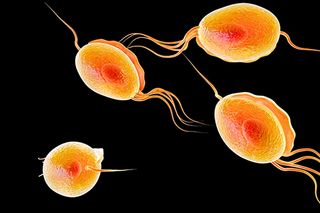
Everything You Need to Know About Trichomoniasis
If you have to get an STI, this is the one to get.

Trichomoniasis is a common sexually transmitted infection (STI). Colloquially referred to as trich, the infection often has no noticeable symptoms, especially in men.
What is trichomoniasis and how is it transmitted?
Trichomoniasis is a disease caused by a bacteria called Trichomonas vaginalis. It is typically transmitted during vaginal sex. This includes penile-to-vulva contact, but it can also be transmitted by touching genitals, even if there is no ejaculation, as in vulva-to-vulva contact. Unlike other STIs, however, trich is not thought to be communicated via anal or oral sex.
It can be passed by a pregnant woman to her baby during a vaginal birth (not a C-section). And pregnant women with a trich infection are more likely to give birth prematurely and to underweight babies.
How prevalent is trichomoniasis? Is there a way to avoid it?
According to the World Health Organization (WHO), 500 million new cases of one of Big Four curable STIs (chlamydia, gonorrhea, syphilis and trichomoniasis) occur each year worldwide. In India, estimates place the prevalence of trichomoniasis at 5% of the general population (that’s 1 in every 20 people).
Anyone who has vaginal sex with someone with a trich infection can catch trichomoniasis. Using condoms or dental dams (a piece of thin, soft plastic or latex) are the best preventative methods, though they are not guarantees against the infection.
What are the symptoms of trichomoniasis?
Trich typically infects the vulva, vagina, cervix and urethra (urinary tract) in women, and in men, the urethra, though an infection in the prostate gland or the tip of the penis is also possible. Trich does not normally infect the mouth or anus in either gender.
Anywhere from 50 to 70% of people with a trichomoniasis infection don’t develop noticeable symptoms; this is especially true for men. This does not mean they are not infectious, however.
When a trich infection does manifest symptoms, typically between 5 and 28 days after infection, signs of trichomoniasis vary between men and women. And trich symptoms, if they do appear, may come and go, rather than be sustained.
In men, trichonomiasis symptoms may include:
- itching or irritation around the penis
- irritation inside the penis
- pain or burning during urination
- frequent urination
- pain or burning after ejaculation
- thin white discharge from the penis
- inflamed genitals, possibly including redness, soreness or swelling around the penis tip or foreskin
In women, trichomoniasis symptoms may include:
- unpleasant, or ‘fishy,’ vaginal odor
- excess vaginal discharge
- vaginal discharge that’s an unusual color, possibly clear, white, gray, yellow or green
- vaginal discharge that’s an unusual viscosity, possibly thinner, thicker or frothier than normal
- vaginal discharge with traces of blood
- inflamed genitals, possibly including redness, burning, soreness, swelling or itching
- pain or burning during urination
- pain during sex
How do you get diagnosed for trichomoniasis?
Trichomoniasis can be typically diagnosed by a swabbed sample of vaginal or seminal fluid.
As with most STIs, if you’ve been diagnosed with a trich infection, it’s important that your current sexual partner and any other recent sexual partners be informed, tested and treated to help stop the spread of the infection. And it’s advisable to get tested for trichomoniasis, and all other STIs, after any unprotected intercourse with a new sexual partner.
What is the treatment for trichomoniasis?
Trichomoniasis can be treated with a course of antibiotics, specifically either metronidazole or tinidazole.
Doctors usually recommend not having sex for at least a week after completing antibiotics, in order to make sure the infection is cured and not spread.
The good news is, if you have to get an STI, trich is the one to get: there are no serious complications from an untreated trichomoniasis infection, though the inflammation may put you more at-risk for contracting other STIs, if you don’t get treated and have unprotected sex.
Can trichomoniasis be cured?
Totally. That said, there’s no immunity to it; it’s entirely possible to catch trich again, even if you’ve already had it once or a thousand times.
This is part of The Swaddle’s series on sexually transmitted infections.
Liesl Goecker is The Swaddle's managing editor.
Related


For Families of Kids with Autism, ADHD, Society Is More Difficult Than the Parenting
